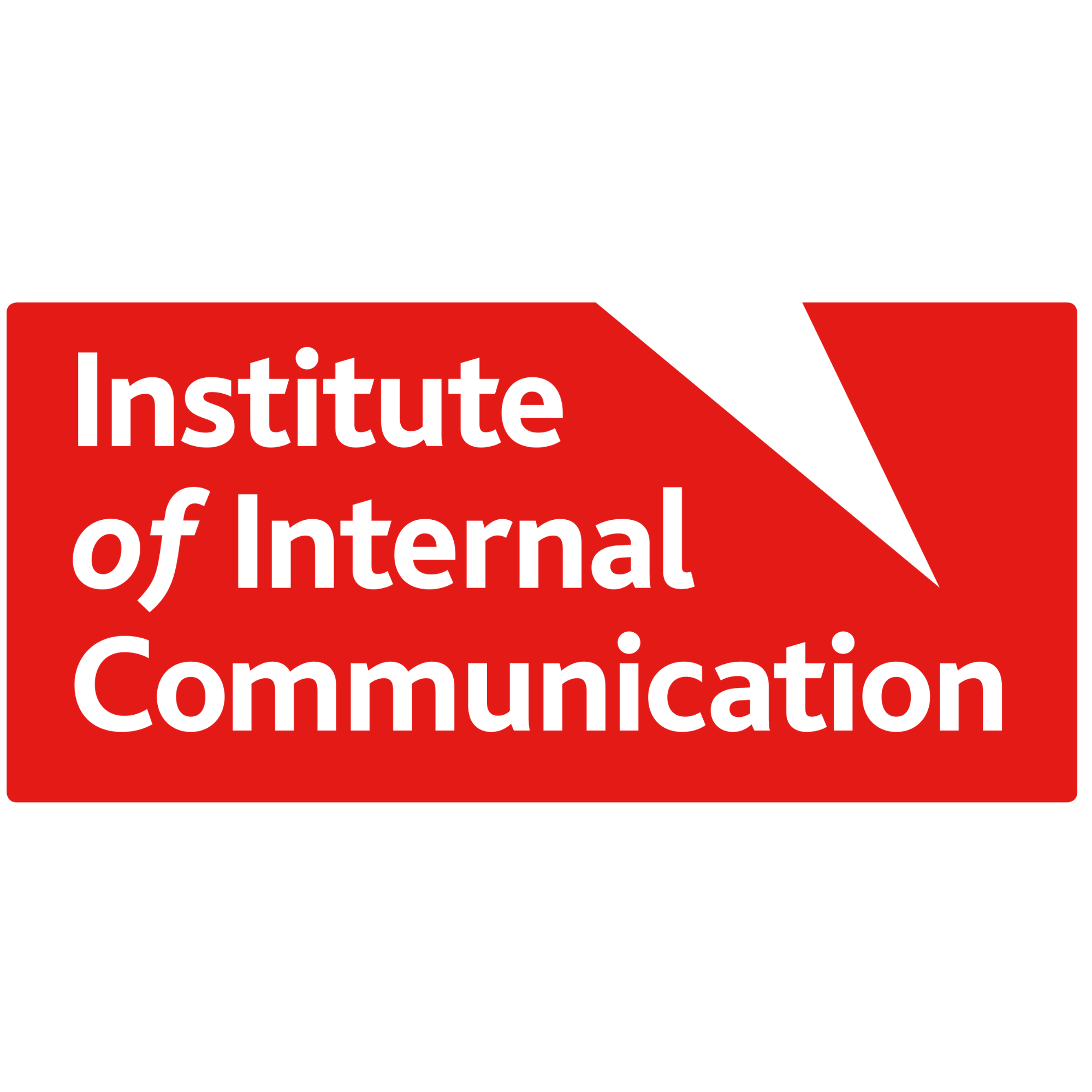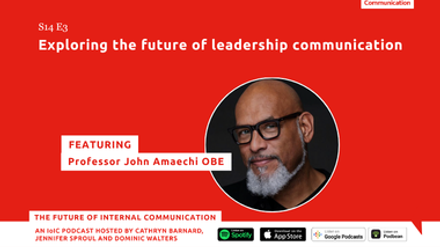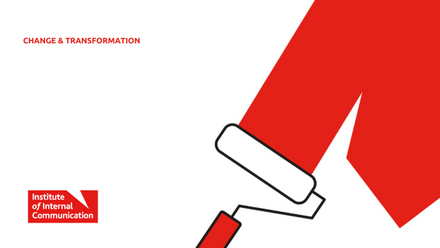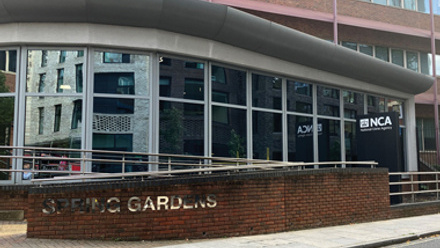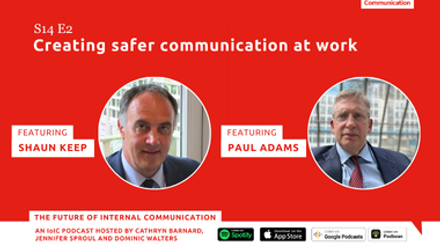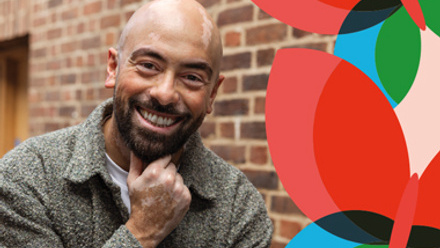IoIC Festival 2022: live blog – day two
Today's line-up looks at topics including engagement surveys, the Great Resignation, purpose, colleague voice, connecting with impact, a culutre of belonging, and the future of impact. Stick with us here on the blog and we'll get down as many top tips and pearls of wisdom as our fingers can type...
09:23
Agamemnon Otero MBE, CEO of Energy Garden, has kicked off day two with the opening keynote. He shares his story about the power of community to drive positive impact for individuals and societies.
Agamemnon starts by telling us he is a failure.
“Every day I fail. I have only so many good ideas I can come up with, and then I have to find whether what it is I thought was the right idea can materialise into something else. Dud ideas can spark creativity from others. We sculpt ideas into a living breathing organism that collectively we can move forward.”
09:26
“Whether it’s in your office or local area, there is an incredible innate power in communities. When you bring them together, you can break through any barrier.”
09:31
Agamemnon tells us about his journey as a man, through two bouts of cancer, during which he was told he was going to die (he didn’t, of course) and was not going to have children (he’s just had a daughter).
He started painting when he first had cancer as a way of communicating, thinking about what brings him alive and in front of the world. “I started with colours and tried to work through those ideas. It wasn’t about me any more, but the 'other’ and the connection between us – my mother and I. And I kept working at it. As an artist, I was trying to visualise the future I wanted to create before I created it. As I flipped the me to we, I realised I had to be in fellowship with others and come up with solutions together.”
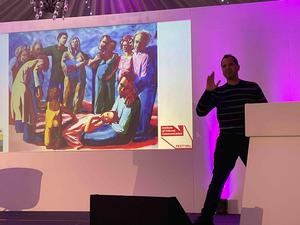
09:43
Agamemnon advises the audience to give people the tools to implement things themselves.
“If you bake bread and give it to people, it’s not going to be as tasty as if they made it themselves. If you give them wheat and they bake it, it will be better. People become a part of the process. That analogy works in any business or programme. Giving people an opportunity to physically integrate into the projects around them changes the way they think."
09:49
“Once you come up with the solution, don’t let it become the very things that bites you. Create the space for things to happen, rather than the directive for what happens. When I’m digging in to things and coming up with solutions, I don’t tell people how to do it, but allow for freedom and creativity along the way.”
09:52
“When people feel engaged and involved, they feel engaged to be part of something. We don’t need smart cities, we need socially smart cities – people who feel empowered to be part of a community and the direction we are going in they have come to collectively.”
09:58
Q. How do you bring resistant or unenthusiastic people along on the journey?
Agamemnon: “Much of the fallout I’ve experienced is from bad vibes which go into the rest of the group – it makes some people at the table not want to get involved. We’re doing door knocking and some people don’t want to hear our idea. What are the questions you are asking and what do you want? What are the questions people are asking and what do they want? Think about how you ask the question. Think about when you are getting negative feedback. The better you ask your question – to yourselves and the people you are working with – the more people will like your idea. And if you still aren’t getting a good response, you’ve got the wrong idea.”
10:09
Q. If you were an internal communicator, how would you apply your ethos to your day to day practice?
Agamemnon: "Look at the space we work in. How can we change the space physically to be more open and creative and inductive to communicating? If there is a space for mood boards, meditation, or space for them to do other things, it will bring people in. If it’s not in our physical environment, it’s hard to bring it into our mental environment."
10:29
Dr Alex Gapud, Cultural Anthropologist at scarlettabbott, is talking about ‘the statistics behind our stories’.
“Most people come from writing and journalism backgrounds. We’re here because we like telling stories. We’re not from research backgrounds, but our senior stakeholders like talking numbers.
“We do surveys by default. We don’t take time to think, should I be doing a survey? Is now the right time. It’s a quick bang for your buck. But we don’t live our lives in numbers. We don’t think, ‘I’m 16 per cent nervous right now’.”
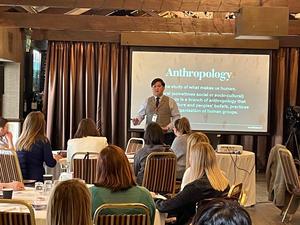
10:34
Where do surveys and statistics struggle?
– how and why
– causality: “Two answers going up in the same direction are not necessarily related to each other.”
– the nitty gritty details of employee engagement
– subjective topics: “What sustainability means to me might be different to what it means to you.”
10:38
From Gallagher’s 2022 State of the Sector report: 84% of respondents believe IC has a critical role in capturing and amplifying employee voice. But only 47% of respondents say their organisation has a robust process for capturing employee insight toad feedback.
“We’re missing a trick, in terms of not just saying we’re listening to people but making people feel they are listened to.” – Dr Alex Gapaud
10:49
What is ethnography, asks Alex? It’s a qualitative research method used by cultural/social anthropologists to understand human behaviour, culture and social interactions through first-hand experience and observation.
It starts with one simple question: What is it really like to work in your organisation…
...as a line manger?
...for teams that are constantly firefighting?
...if you’re from a diverse background?
..on the frontline?
Which rules do people follow and which do they break?
What are the core issues with attention and attrition? What are the cultural challenges of hybrid or M&As…
11:13
Marghaid Howie, global head of social media & continuity communications for Thoughtworks, is talking about creating an inclusive comms plan.
She shares a quote from SheEO activator Rita Mitjans: “Diversity is the ‘what’, inclusion is the ‘how’.”
11:15
On a gender perspective, Marghaid says: “Think about your speaker line-up. People think at town halls, employees want to hear from MDs… Well, not necessarily. People want to hear about leaders who are like them. Think about your speaker line-up.”
11:22
On supporting colleagues with disabilities – and, for example, people who are heard of hearing, Marghaid reminds us: “People can’t always lip read. Captions are crucial. Find out if you have the budget for a sign language translator. If you have one person signing in to a webinar or turning up to away days who cannot hear, how will they know what’s going on?”
11:50
In the inspriration zone, leadership and talent expert Rhiannon Stafford is talking about the Great Resignation. In the Q&A session: In instances of strikes and industrial action, should IC be on the side of employees in these situations or on the side of company leadership? Will we lose credibility if we pick a side?
“Do we have to pick a side?" considers Rhiannon. "Stay out of it if you can. Remain honest and authentic and do your best to respond with clarity and truthfulness. Picking a side means there is someone on the other side who is going to lose.”
11:52
Q. HR leaders can be keen to keep their own hands on the levers of power around employee experience. What’s your advice to IC pros who are banging on the door but are consistently excluded by HR?
Rhiannon: “Agamemnon talked this morning about asking the right questions, or different questions. If you feel pushed out, what can you do to speak their language to reassure them about what you can do? It’s not that you are taking anything away from what they are trying to do, but ask what type of employee experience are they trying to create, and what can you bring to that common goal.”
12:41
At the start of our afternoon session, Emma Moncur Kemp, internal engagement manager at National Galleries of Scotland, is talking about 'when purpose makes passion' – and the organisation's case study.
A year ago, the team started thinking about how to engage employees in the purpose of making art work for everyone.
“We wanted to create a moment in time to start us looking forward again," says Emma. "We set out to create a shared understanding - not just words on a page and a logo, but what it means; we wanted to re-energise people; and we wanted to bring the purpose to life internally with the same effort and dedication we do externally.”
The team created the Our Big Picture experience – a visitor experience for colleagues: what it looks like when the brand and strategy comes to life for people. “We aimed to demonstrate the purpose through and through in what we do and say, and allow people to choose their own adventure and take ownership in the direction, through something inclusive and colleague-led.”
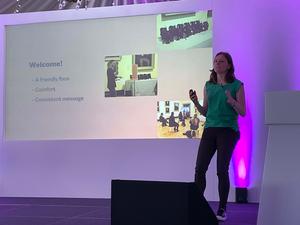
12:52
In each of three rooms in one of the galleries, the team looked at a different strategic aim, using colour, music and activities, so people had a journey. It helped people understand what it was like to be a visitor and allowed them to add their own thoughts to displays.
“All used ideas from colleagues, current work and tech we already had and showcasing thins we already did tied back to strategic aims – all with opportunities for feedback. In the end zone, we brought leaders in, and had a one-page strategy. We did it at the end, because we wanted people to explore, choose their own adventures and have those thoughts before having an informal conversation with leaders.”
12:57
Emma talks about the three ways National Galleries of Scotland achieved its goal.
1. Start from the strategy and purpose.
“We spent time up front with leaders and asked, what is different about the new strategy and what are the key things to get across to colleagues? What do we want them thinking all year when they work? And we got the big decisions agreed up front: where we’d host it, and that it would be colleague-led.”
2. Create with colleagues.
“We had open Ideas sessions with colleagues – where can we find the connections in the work you do to illustrate the purpose? We stuck with the colleague-led approach throughout the process and worked with those colleagues to develop it.”
3. Deliver with dedication to detail.
“We gave it the same commitment and detail as we would normally take for an external experience – risk assessments, talking with curators, looking at accessibility.”
13:09
Emma's top three lessons from rolling out a campaign to link people to the purpose:
1. Be clear who you’re involving, when and why.
2. Be realistic about your timeline.
3. Doing something different takes us out of our comfort zone.
13:30
One of our afternoon sessions is beginning: Bring out your Best Self and communicate with impact: Discover the power of PRINT, with Victoria Garratt and Kay Vessey.
13:32
This afternoon’s panel session looks at ‘creating a culture of belonging’, facilitated by Ryan Curtis-Johnson (director of communications, The Valuable 500) with panellists Belinda Asante (group I&D strategy partner for Lloyds Banking Group), Sarah Kemp (UK head of comms and group comms lead for PageGroup) and Caroline Owen (head of internal communication, Hoxby).
The session kicks off with a powerful video from Valuable 500, whose work includes engaging with 500 business leaders about make disability part of everyone’s business. The video highlights that one in seven people have a disability, but they face barriers in the workplace.
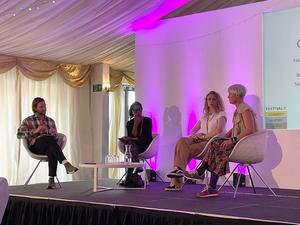
13:37
What make a good inclusive culture in business and within comms? Belinda Asante says: “We can only have the right messages if we lift up the people voice. I work with employee networks to ensure it’s authentic, meaningful and is what our colleagues want. You need the right tone of voice and positioning. And be flexible for the right audience. The same message will land differently with different audiences. We encourage intersectionality across employee networks and sometimes the message can get diluted, but sometimes it gets enhanced.”
13:41
Caroline Owen: “The more we are able to include people, the more diverse your employee group becomes. With that comes cognitive diversity, and with such a broad range of diversity you produce your most refreshing work.”
13:46
How do we make the messages land and accessible for all?
Sarah Kemp acknowledges it’s a tricky challenge. “‘Accessible for all’ is a really hard term, as everyone has different needs. We implemented ClearTalents, a profiling tool that helps us understand our population gathers data if employees want to disclose a disability to manager, and the manager can work with them to make the relevant adjustment to individual, and that’s fed back to comms.”
13:51
Data and comms are key to getting the support and comms right for people with disabilities, says Belinda. “Get it right for your business. What other companies are doing are not necessarily going to work for your employees. We run data every week as we have people leaving and coming in and we need to understand what it looks like today.”
14:11
Ryan asks the panellists for their key takeaways for improving accessibility
- Caroline: Ask questions, take advice, don’t make assumptions and celebrate the successes brought about through cognitive diversity from inclusion.
- Sarah: Speak to the right people, don’t be ignorant in thinking about what you can communicate.
- Belinda: Be bold – even if it’s just bold for your organisation. What is your message and what are you trying to do with it? Use your values and make sure they are a constant thread. Be authentic – people will be OK if you make mistakes but do it for the right reasons.
14:23
Our final panel session of #IoICFestival22 is on the future of internal comms as an enabler of organisational success, chaired by Working the Future director Cat Barnard, with panellists Eduvie Martin (group internal comms manager for British American Tobacco), Laura Colantuono (internal comms professional) and Joe Salmon (associate director, people and purpose, at Hill+Knowlton).
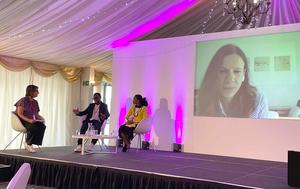
14:26
How do we manage Internal Comms in a time of uncertainty?
Laura says: “Keep people connected to the purpose. Be more clear about the strategy, as well as upskilling ourselves to be on top of trends and understand the external world and be able to support our narrative. And really claim the place in the sun after the storm. If I have been in crisis mode for 18 months, not it’s time to be seen.”
14:28
Engagement of the workforce is the expectation, says Joe Salmon. “Moving forward, we will get to a point of growing businesses from the inside out. So whenever there is a new product or service that is external, we know our employees will be out there doing and saying the right thing. How can we influence them in such a ways that they are interacting with our content on social media and our employees are going to show up and support us externally. We need to raise the bar.”
14:37
What are the key challenges we face?
Joe Salmon reflects: “Because of how we have performed over the past couple of years, it’s shone a spotlight on what we do, but the expectation from organisations is that we will deliver at the same pace, get results and continue to deliver value.
“There is also the need to communicate with disconnected audiences. Many of us have workforces with no laptops, they don’t log in during the day and they can’t bring their phones to work. They often get forgotten. How will they get attention from us and how do we lift our service for them?
“Why do we want an engaged workforce? What do we want them to think, do, feel differently? When we get a high engagement score, what do we do with it? Is it brand advocacy?”
14: 51
If there’s more demand for IC, what should we stop doing to engage with the workforce? “Strategy v tactics,” says Cat.
“We’ve been so busy in the doing, we don’t have time to stop and breathe,” says Laura. “We don’t have time to think how things can or will work if we keep doing things. See what is the return on investment of what we do. Is everything we do strategic and needed? Our role is no longer to send out comms, but the risk is we are going back in the closet. We want to be visible.”
Joe offers: “We all have newsletters we do every month. If you pull the plug on one, and no one complains. How valuable was it? If you are spending seven hours writing intranet articles and only 40 people are reading them, is it worth it? How do we streamline what we do to add value?”
14:55
Focus on the value-add that the function creates, says Eduvie. “Toolkits are fantastic – if you have the right layouts, you are saving people time. When you understand the organisation, strategy and purpose, you want to reach out to stakeholders and show where you can offer value – like a proactive journalist. It will put you in the right spot to offer the value the organisation needs.”
15:02
How can we challenge leaders about the pace and volume of change?
Joe Salmon: “The rules are changing. It used to be ‘don’t send out newsletters on a Friday’, but now people are trying not to book in meetings on a Friday and they have more time to read.
“Find out your hero channel and use that for things like CEO messages, big updates and big campaigns. But don’t give every piece of content the same approach and don’t use a cookie cutter version. Don’t split your conversation across Yammer and Workplace, as you miss the value of having things in one place.”
15:15
TEDx speaker Gina Buckney is talking in her closing keynote about empowered communication for employee wellbeing.
Communication is a power skill – no longer a softer skills. These are Gina’s four power skills: mental wellness (“mental health has negative connotations,” says Gina), emotional intelligence ("more valuable than IQ – it's the EQ that will connect you wirh people and help you engage and udnerstand when someone is not feeling well"), resilience and personal agility.
15:20
Resilience is what protects us, but what does it mean to you? How would you explain it to a five year old?
Someone in the audience offers: “Carrying on when you think you can’t.” Another shout-out: “Getting back up when you get knocked down”
For Gina, it’s the armour you put on at work – the “Superman cape”.
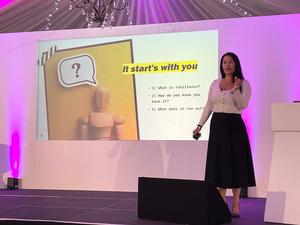
15:26
What are the mistakes of pushing yourself to deliver a project to the point that you burn out and have a breakdown?
– Always saying yes and not wanting to let people down.
– Ego gets in the way. “I always deliver.”
– Not speaking up, or not loud enough or in the right language.
– Being a control freak.
15:34
What mistakes could leaders make in not supporting teams working through extreme workloads?
– Human connection and understanding is lacking
– Not moving the goalposts – if it’s not life and death, why does something have to go live at a certain time?
– It’s about numbers, rather than the human experience
– They send you a link or a number to wellbeing training – a detached, unemotional response.
15:40
Alarming stats from Gina: in the UK, 822,000 people suffer from work-related stress, depression or anxiety, resulting in 17.9 million days lost.
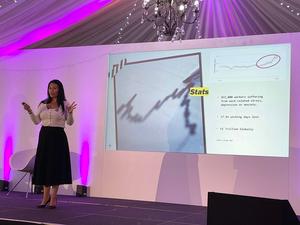
15:49
Gina tells a story of being recruited aged 26 to be an ops and engineering manager of 144 engineers, with no experience of operations and engineering. Her appointment… didn’t go down well.
What Gina did
– she took 15 minutes with each engineer to look for common themes, and she was open in admitting she didn’t know about operations and engineering.
– she put water filters in hot environments, as the common theme was that there was no running water. “That won over half the staff. I used empathy and I acted. It was a small quick win.”
– she created a communications team, sharing news and stories with the engineers
– she put on a Christmas party. “I was told immediately most of them wouldn’t come and mix with managers. I did it anyway. No one had ever done it before. I had an open bar and made sure they had a great time. It trickled down to people who didn’t come.”
The result? Her team came out top of 20 operations teams. “I listened and they knew I had done something different for them. That’s the power of communication.”
16:04
And that's a wrap. It's been a hugely successful Festival... And we will be back next year – this time in Welwyn Garden City, 14-15 June 2023. Look out for future communciatiuons!
